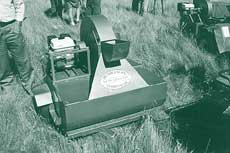
Grassed up - Seed harvesting and processing
Seeding characteristics
Most 'domesticated' grasses such as cereals have been selected to retain seed in the heads for a single destructive harvest. Australian native grasses have inflorescences (seed heads) and seed structures that are far better adapted for the natural processes of seed dispersal by wind, water and animals than for man-made seed harvesters. One such adaptation is the differential flowering and ripening of seed that is common in our grasses. Seed is produced progressively along the inflorescence, and inflorescences are produced progressively on the plant throughout the growing season (Picture 1). As the seed ripens it falls to the ground (for most native grasses seed retention is low) widening the interval during which fresh seed is available to germinate. This process increases the chances of seedling survival in an extremely variable climate. It also poses a problem in terms of time of harvest and harvest efficiency. Some native perennial grasses have determinate flowering, i.e. each plant has only one flowering period each year, and some are indeterminate, i.e. can flower more than once a year, often in response to rainfall.
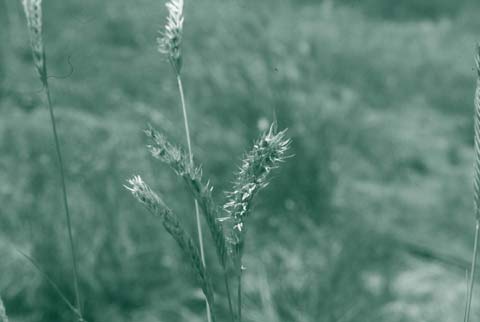
Some native grasses give the appearance of indeterminate flowering but are, in fact, determinate. For example, in populations of Themeda triandra (Kangaroo grass) individual plants may not all flower at the same time, some plants producing flowers early in the summer, others flowering in response to rainfall later in the season. However, each plant produces only one lot of seed heads each year. Elymus scaber (Common wheat grass) on the other hand tends to behave as a determinate flowering plant in areas where summer rainfall is less dominant producing flowers only in the spring. Where summer rainfall is more dominant the species may behave as an indeterminate flowering grass (see Section 5).
Whilst most native grasses drop seeds as individual units spikelets (Spikelet consists of one or more florets and is the basic unit of the inflorescence in grasses) or florets (Floret - The flowering part of a grass, includes the lemma and palea, the term is also used if some parts are absent and can refer to a lemma only), in some cases the whole inflorescence (Inflorescence - a group of flowers borne on a stem) can break off (e.g. Chloris, and Enteropogon). Individual spikelets can then be shed as they are blown around by the wind.
Native grasses also have a wide range of habit and form which are characteristic of individual species or genera. The seed head architecture also varies considerably. For example, some species have 'spike-like' heads where flowers are borne singly or in cylindrical clusters close to the stem (e.g. Astrebla, Paspalidium). Commonly seed heads are an open-branched 'panicle' (Panicle - a compound or branched raceme) (e.g. Panicum, Eragrostis) or consist of finger-like (digitate) branches (e.g. Bothriochloa, Chloris, Dichanthium, Enteropogon). These are shown below.
Seed head height and size varies not only among species but can also vary for any one species in response to different grazing patterns, weather patterns or throughout the growing season. These factors, as well as maturity at harvest, can also affect seed viability. Even when seed contains a viable embryo, immature seeds are low in energy reserves and when harvested and sown, often fail to produce a healthy seedling. The timing and methods of seed harvesting should always be aimed at collecting the maximum number of mature seeds.
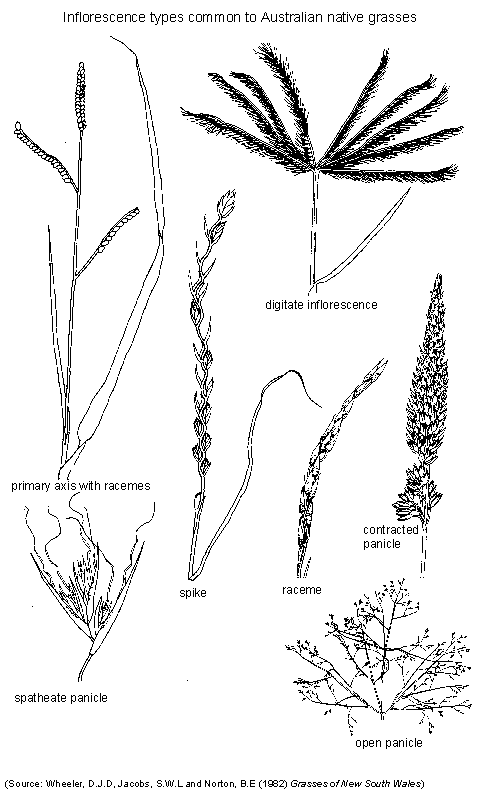
Native grass seeds often have hairy structures, a callus or long awns which make seed light, fluffy and difficult to handle. These appendages may play a role in helping to locate the seed in a more suitable micro-climate and thus aid germination and seedling establishment. Hygroscopically (Hydroscopic - responds twists or opens to moisture changes) active awns (Awn - an elongated bristle-like appendage attached to the apex, back or base of the glume, lemma or palea) are capable of burying seed of Austrostipa spp. and T. triandra whilst the hairy lemmas (Lemma - the outer bracts at the base of a grass spikelet; usually two glumes are present) of Austrodanthonia spp. are thought to allow for dispersion by wind and to control water uptake by the seed. Hygroscopically passive awns also affect the orientation of dispersal units as they fall to the ground. Seeds of such species (e.g. Microlaena stipoides and Aristida spp.) which land upright with their callusses buried in the soil have a better chance of successful establishment than those lying flat on the soil surface. Whilst these structures and the fashion in which seed is produced often make conventional harvesting and processing methods inappropriate, they are adaptations that have aided in the survival of these species.
The combination of the above factors results in many samples of native grass seed being of poor quality with low proportions of mature and viable seed. On the other hand, if sufficient rain falls, (or crops are irrigated), seed set and ripening can be protracted resulting in higher seed yields and better quality samples. It appears possible to manipulate the flowering of at least some indeterminate species by irrigation so that many seeds mature at the same time, making harvesting easier.
Methods of seed harvesting
Non-mechanical methods
Hand harvesting is an arduous task and seed yields are low. It can be the only feasible method of seed collection when a plant is rare, of limited local occurrence or in an inaccessible area. Seed heads can be individually cut off or seed stripped from the inflorescence (Inflorescence - a group of flowers borne on a stem) by running a hand from the base of the inflorescence upwards. In some cases (e.g. T. triandra), seed has been harvested by cutting the entire stem (culm - a grass stem), and allowing the seed to mature in the head and be shed over time. In such cases culms can be transported to the revegetation site immediately following harvest.
Conventional mechanical harvest techniques
It is the unique seeding characteristics of native grasses that make seed harvesting difficult using conventional direct harvesting methods. Exceptions includeAstreblaandElymusthat have a high degree of seed retention and can therefore be harvested using conventional machinery. SomeAustrodanthoniaspp. also have a high degree of seed retention but are unsuited to direct heading because of the light fluffy nature of their seed. Windrowing followed by threshing the dry crop has been used with limited success to harvest seed from these species.
Trough, beater and brush harvesting
The light, chaffy nature of native grass seed lends itself to beater, and in particular, brush harvesting techniques. Trough and later beater harvesters were developed in Queensland to collect seed from Heteropogon contortus (black spear grass) and the exotic grass, Cenchrus ciliaris (buffel grass). In their simplest form, trough harvesters are simply a trough fixed on the front of the vehicle at an appropriate height. As the vehicle is driven through the crop ripe seeds fall into the trough while immature seeds remains on the plant to be harvested later. Troughs are not effective for species with light and fluffy dispersal units as they tend to blow out of the trough.
The brush harvester has proven to be the most useful harvesting technique for a wide range of grass species. This is a non-destructive harvesting technique that allows for multiple harvests of a stand of grass. In this way it overcomes some of the difficulties by removing ripe seed only resulting in increased yields of viable seed.
The original concept of the brush harvester comes from an American design, the Woodward Flail-Vac Seed Stripper that was developed in the early 1980Õs. The central concept of the brush harvester is a flailing brush which rotates upwards at its leading edge. This design has meant fewer stems are broken during harvest, as well as a cleaner product compared with conventional direct heading methods. A metal shroud over the brush creates a cross flow fan action that generates sufficient air velocity to gather seed heads into the flailing brush. The shroud also directs the flow of air and seed into a wedge-shaped seed hopper behind the brush. The triangular shape of the seed collection bin reverses the direction of airflow, depositing the seed into a dead air space on the floor of the bin while air escapes through the exit vent. These various components are illustrated in Figure 1.
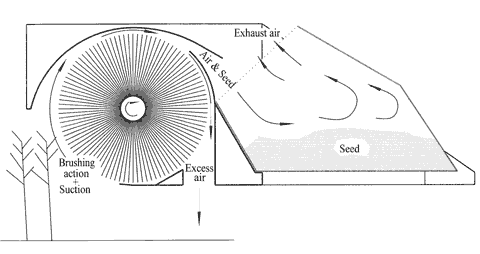
Subsequent Australian adaptations of the original American brush harvester have seen a number of designs available commercially in recent years. One such machine, the 'Trangie brush harvester', designed and built by NSW Agriculture, can be towed behind any vehicle and has adjustable harvest height and brush speeds (Picture 2). Another more mobile adaptation, 'The grasshopper' designed by DLWC is easily serviced and has manual harvest height adjustment (Picture 3). Brush harvesters need not be large and a small hand-held brush harvester has been designed and build in Queensland by Grass Seeds Australia, Darling Downs (Picture 4).
Picture 2. The user friendly 'Trangie brush harvester' has an adjustable brush speed and harvest height as well as a seed bin that can be automatically emptied. (Photograph C. Waters)
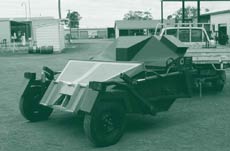
Picture 3. The DLWC 'Grasshopper' is light weight (500–750 kg), has adjustable brushes and harvest height. The 'off-set' working position facilitates harvesting ripe seed that has not been disturbed by the towing vehicle. (Photograph C. Huxtable)
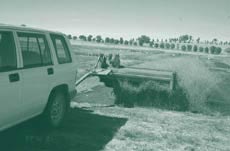
Picture 4. A hand held brush harvester designed to collect seed from small, inaccessible areas. (Photograph I. Cole)
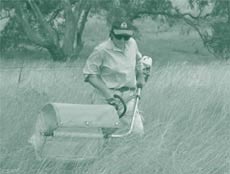
Picture 5. A reel and brush harvester which gathers culms with inflorescences over the top of a rotating brush to deposit the seed in a seed hopper. Designed and built by J. Stafford, Vegetation Management Services, Main Rd, Lenswood. SA 5240 (Photograph R. Whalley)
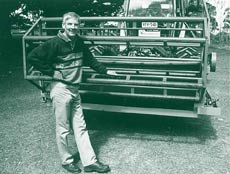
Suction or vacuum harvesting
The dispersal units of some native grasses (e.g. M. stipoides) are very easily removed from the inflorescences, even when they are in the early stages of development. Hand-held commercial outdoor vacuum cleaners can be used to harvest this type of seed and tend to remove only mature seed.
Vacuum cleaners are only suitable for harvesting small areas because the intake is quite small (say 12 cm x 8 cm) (Picture 6).
Picture 6. An electric garden vacuum cleaner can be used successfully to harvest small areas of M. stipoides. (Photograph C. Waters)
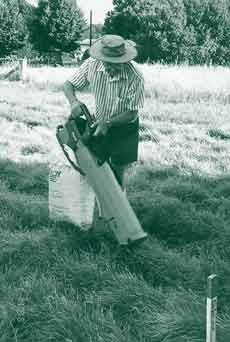
The success of these hand-held machines stimulated inventive groups of farmers to develop small vacuum harvesters with a wider intake (about 1 m wide) for harvesting larger areas of native grass seed. One of these, 'The Scorpion', is self-propelled and was designed and constructed by members of the Barney's Reef Landcare Group (Picture 7).
Picture 7. The ‘Scorpion’ vacuum harvester, designed for harvesting native grass seed and built by members of the Barney’s Reef Landcare Group in collaboration with DLWC and Rosevale Engineering, Gulgong. (Photograph R. Whalley)
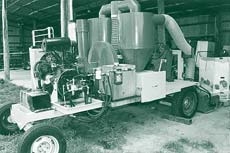
A final modification to this machine includes a combination of vacuum and brush (Picture 8).
Picture 8. The ‘Rosevale Reaper’ is a re-design of the original ‘Scorpion’ allowing for the harvester to be utility mounted and easily transported. (Photograph I. Cole)
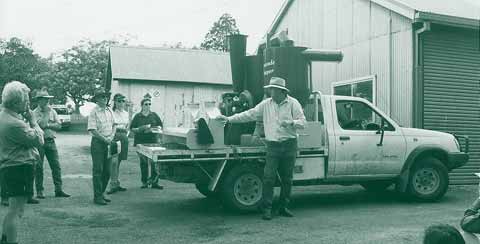
A second suction harvester, 'The Bushranger' (Picture 9) grew out of a Community Grasses Project funded by the Murray-Darling Basin Commission and won 2nd prize in the design and construction section at the Australian National Field Days, Orange in 1996. 'The Bushranger' is towed behind a four-wheel motor bike using an offset towbar. It is likely that vacuum harvesters designed for sub-clover and medic seed harvesting could be modified to harvest large areas of native grass seed by removing the threshing drum and modifying the height adjustment.
Picture 9. The ‘Bushranger’ vacuum harvester for native grass seeds was designed and built by John Betts and Tony Wilson of Yass, NSW in a project funded by the Murray-Darling Basin Commission. (Photograph R. Whalley)
